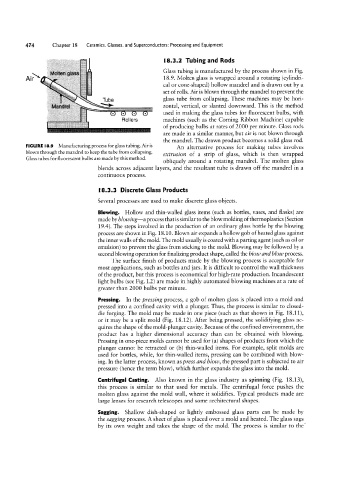Page 494 - 04. Subyek Engineering Materials - Manufacturing, Engineering and Technology SI 6th Edition - Serope Kalpakjian, Stephen Schmid (2009)
P. 494
i j cal or cone-shaped) hollow mandrel and is drawn out by a
474 Chapter 18 Ceramics, Glasses, and Superconductors: Processing and Equipment
l8.3.2 Tubing and Rods
naman ass
j
18.9. Molten glass is wrapped around a rotating (cylindri-
AiP* - sg; Glass tubing is manufactured by the process shown in Fig.
set of rolls. Air is blown through the mandrel to prevent the
glass tube from collapsing. These machines may be hori-
piéantifetj
Tube
zontal, vertical, or slanted downward. This is the method
s
s
1
used in making the glass tubes for fluorescent bulbs, with
machines (such as the Corning Ribbon Machine) capable
Rollers
of producing bulbs at rates of 2000 per minute. Glass rods
are made in a similar manner, but air is not blown through
the mandrel. The drawn product becomes a solid glass rod.
FIGURE I8.9 Manufacturing process for glass tubing. Air is An alternative process for making tubes involves
blown through the mandrel to keep the tube from collapsing.
extrusion of a strip of glass, which is then wrapped
Glass tubes for fluorescent bulbs are made by this method.
obliquely around a rotating mandrel. The molten glass
blends across adjacent layers, and the resultant tube is drawn off the mandrel in a
COI1tlI'1LlOU.S PITOCCSS.
l8.3.3 Discrete Glass Products
Several processes are used to make discrete glass objects.
Blowing. Hollow and thin-walled glass items (such as bottles, vases, and flasks) are
made by blowing-a process that is similar to the blow molding of thermoplastics (Section
19.4). The steps involved in the production of an ordinary glass bottle by the blowing
process are shown in Fig. 18.10. Blown air expands a hollow gob of heated glass against
the inner walls of the mold. The mold usually is coated with a parting agent (such as oil or
emulsion) to prevent the glass from sticking to the mold. Blowing may be followed by a
second blowing operation for finalizing product shape, called the blow and blow process.
The surface finish of products made by the blowing process is acceptable for
most applications, such as bottles and jars. It is difficult to control the wall thickness
of the product, but this process is economical for high-rate production. Incandescent
light bulbs (see Fig. 1.2) are made in highly automated blowing machines at a rate of
greater than 2000 bulbs per minute.
Pressing. In the pressing process, a gob of molten glass is placed into a mold and
pressed into a confined cavity with a plunger. Thus, the process is similar to closed-
die forging. The mold may be made in one piece (such as that shown in Fig. 18.11),
or it may be a split mold (Fig. 18.12). After being pressed, the solidifying glass ac-
quires the shape of the mold~plunger cavity. Because of the confined environment, the
product has a higher dimensional accuracy than can be obtained with blowing.
Pressing in one-piece molds cannot be used for (a) shapes of products from which the
plunger cannot be retracted or (b) thin-walled items. For example, split molds are
used for bottles, while, for thin-walled items, pressing can be combined with blow-
ing. In the latter process, known as press and blow, the pressed part is subjected to air
pressure (hence the term blow), which further expands the glass into the mold.
Centrifugal Casting. Also known in the glass industry as spinning (Fig. 18.13),
this process is similar to that used for metals. The centrifugal force pushes the
molten glass against the mold wall, where it solidifies. Typical products made are
large lenses for research telescopes and some architectural shapes.
Sagging. Shallow dish-shaped or lightly embossed glass parts can be made by
the sagging process. A sheet of glass is placed over a mold and heated. The glass sags
by its own weight and takes the shape of the mold. The process is similar to the

